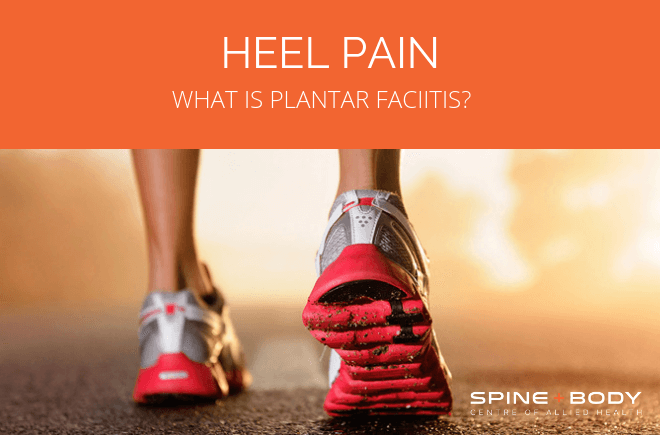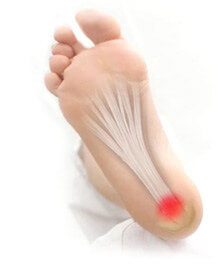Heel Pain (Plantar Fasciitis)

What is plantar fasciitis?

Inflammation or tearing of the tense band of fibres situated on the sole of the foot.
what does the plantar fascia do?
It assists in holding up the arch of the foot in conjunction with other supporting ligaments. It also assists in protecting the foot from piercing injuries when walking barefoot as it is made up of a combination of strong collagen bands interspersed with a layer of fat padding.
what causes Plantar Fasciitis?
- Sports that place additional stress on the heel bone due to running on the toe rather than the heel such as; running, ballet and aerobics
- Working in a job that requires excessive walking or standing on a hard surface
- Structure of the foot, for example flat feet, high arches, tight calf muscles or Achilles
- Incorrect footwear that doesn’t provide adequate support, cushioning or are old
- Carrying excess weight places additional strain on the Plantar Fascia
- Aging, more common in middle aged people
how do i know if i have plantar fasciitis?
Symptoms may emerge gradually with the prime characteristic being stiffness and difficulty walking after prolonged sitting or immobility. Generally this eases after a few minutes. There is often a focal pain concentrated on the heel at the rear end of the foot arch. The plantar fascia attaches to one singular point at the rear of the foot compared to the five attachment points at the base of each of the toes in front of the foot hence, when the plantar fascia is tight, this singular point receives an excessive amount of tensile force compared to the forefoot.
what investigations do i need to confirm that this is my problem?
A clinical examination by your physio to check for tenderness in your foot and the exact location of the pain to make sure that it’s not caused by a different foot problem
An ultrasound scan or an MRI will confirm the diagnosis and will also identify whether there is a partial tear of the fibres of the plantar fascia where repeated stress may have caused breakdown of the tensile tissue. These investigations or an xray will also identify whether a calcaneal (heel) spur exists. A heel spur results from repeated traction trauma to the heel attachment site of the plantar fascia resulting in gradual deformation of the bone.
Treatment for plantar fasciitis
There are two aspects that need to be considered when treating plantar fasciitis. Firstly, we need to treat the acute inflammatory response that is causing pain and dysfunction.
The standard anti-inflammatory methods are generally useful and these include the use of ice, rest from provocative factors such as high impact loading, the use of protective footwear and anti-inflammatory medication if this is approved by your medical practitioner.
The important aspect is to assess the underlying biomechanics that may be causing the problem. Important considerations include tight calves and excessive pronation (flattening) of the arch placing excessive tissue force on the plantar fascia.
Can cortisone injections assist in alleviating my pain?
In general terms, cortisone is an anti-inflammatory and can rapidly assist in alleviating the inflammatory process. In the case of plantar fasciitis however, it is strongly advised that cortisone NOT be used as it has been demonstrated to thin the protective fat layer in the fascia and can result in cellular changes to the collagen which may precipitate a tear in the tissue.
Above all, seek early physiotherapy intervention so that you can continue to Enjoy Life Without Pain.





